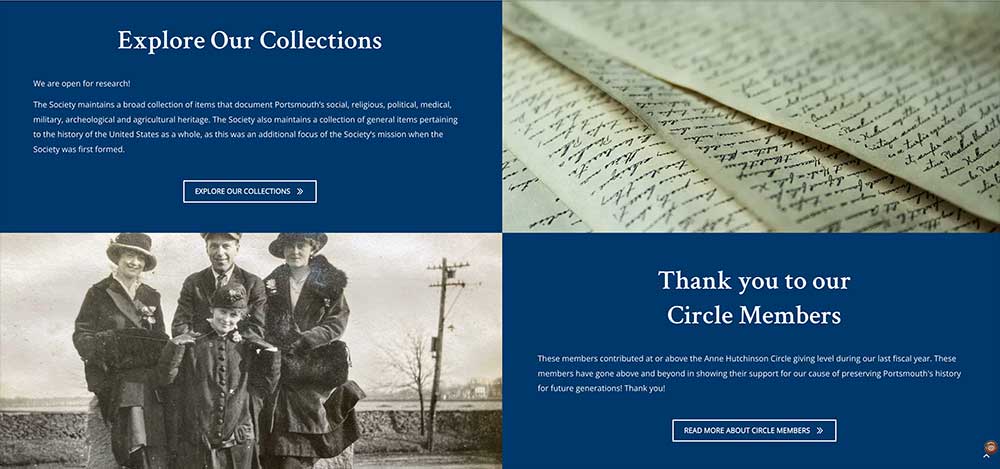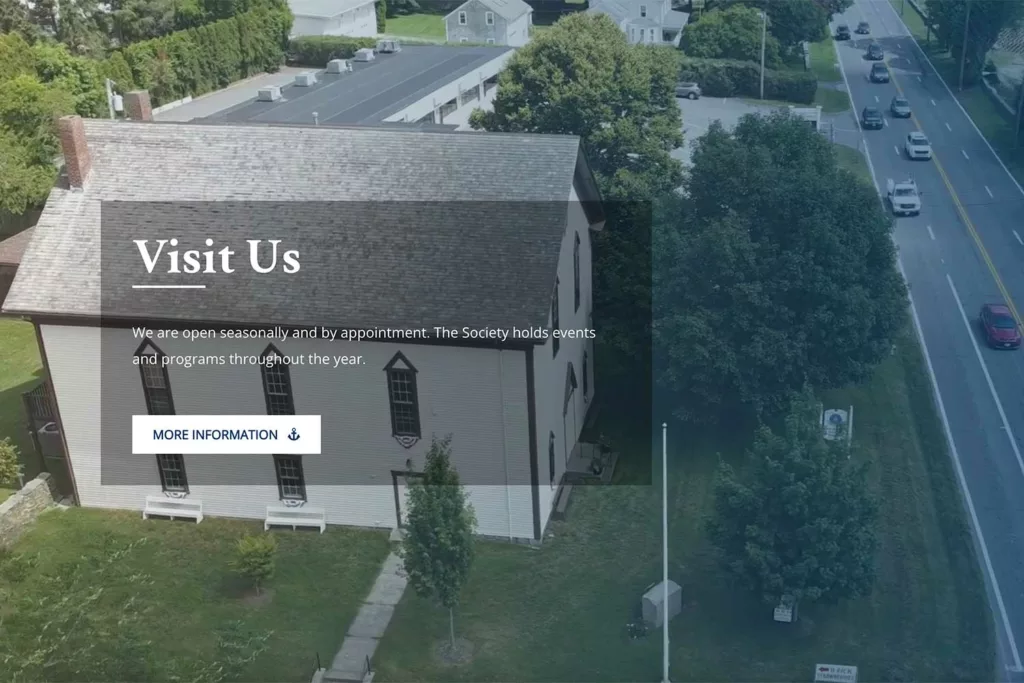Picture this: a digital portal that transports you through time, unveiling the hidden gems of history with each click. Welcome to the world of historical society websites! These online treasure troves hold the keys to the past, but creating one that’s informative and captivating is no small feat. But we reveal what’s needed For Building an Effective Historical Society Website.
Whether you’re a history buff, an archivist extraordinaire, or just someone with a curious penchant for the past, building an effective historical society website requires a unique blend of storytelling finesse, user-friendly enchantment, and a touch of digital magic. I know the team here at Slocum Studio enjoyed building this reference website.
In this blog, we don our virtual historian hats to uncover the best practices for crafting a historical society website that not only preserves the bygones but also makes them come alive.
So, fasten your seatbelts, fellow time travelers, as we embark on a journey through the ages of web design, content curation, and engagement magic – all to unearthing the secrets to building a genuinely extraordinary historical society website!
Choosing a Compelling Historical Theme
Explore how to select an engaging theme that aligns with your historical society’s mission and captivates your audience. There are a couple of ways to go about this.
If you’re feeling adventurous and have experience with WordPress, you can select a theme from our affiliate theme company by clicking on the graphic below. And customize your chosen theme. Or you can have us do this for you.

Choosing a compelling historical theme is pivotal in creating an effective historical society website. Your theme is the digital gateway to your organization’s rich heritage, setting the tone and engaging visitors from the moment they land on your site.
To make an impactful choice, consider your historical society’s mission, goals, and the stories you aim to tell. A theme should resonate with your target audience, reflecting the historical periods or topics that hold significance. It should also provide a visually appealing and user-friendly experience that draws visitors deeper into your site’s content.
Moreover, a compelling theme should be adaptable and responsive, ensuring it looks and functions seamlessly across various devices. Accessibility and readability are paramount, allowing users of all ages and backgrounds to explore and appreciate your historical offerings.

The Portsmouth Historical Society website is a customized Astra Theme. We often start with a basic theme and customize it from that point.
In essence, your chosen theme becomes the virtual embodiment of your historical society, conveying its identity and inviting individuals to embark on a digital journey through time. So, take the time to select a theme that showcases your history and captures the hearts and minds of your online visitors.
Content Curation Strategies
Learn effective methods for curating and organizing historical content, including artifacts, documents, and multimedia, to create an immersive user experience For Building an Effective Historical Society Website.
Effective content curation strategies for historical society websites are essential for presenting a well-organized, engaging, and informative online presence. These strategies involve carefully selecting, managing, and presenting historical content to captivate your audience while providing meaningful historical insights.
To excel in content curation, conduct comprehensive research to identify valuable historical resources, including artifacts, documents, photographs, and multimedia. Prioritize content that aligns with your historical society’s mission and resonates with your target audience. Then, organize and categorize this content logically to create a user-friendly experience, making it easy for visitors to explore and discover historical treasures.

Implement a regular updating schedule to keep your website fresh and relevant, and consider multimedia elements like virtual exhibits, interactive timelines, and engaging narratives to tell compelling historical stories. Additionally, ensure your content is optimized (SEO) to improve its visibility and accessibility.
By employing effective content curation strategies, you can transform your historical society website into a digital repository of historical knowledge, fostering visitor engagement and appreciation while preserving and promoting the rich heritage you aim to share.
User-Friendly Navigation and Search
In this section, you will learn how to design intuitive navigation and implement robust search functionality, ensuring visitors can easily explore your historical society’s wealth of information.
User-friendly navigation and search are vital components of a successful historical society website. These features ensure that visitors can seamlessly explore your digital archives and access the historical information they seek.
Organize your website’s content into clear and intuitive categories to create user-friendly navigation. Implement a well-structured menu that leads users to specific historical eras, topics, or exhibits. Employ a breadcrumb trail and clear calls to action to guide visitors through your site.

A practical search function is equally crucial. Incorporate a robust search bar with filters and advanced search options to help users pinpoint the desired information or artifacts. Implementing metadata and tagging for historical items can enhance search accuracy.
Remember that historical society websites often cater to diverse audiences with varying levels of technological proficiency. Ensure your navigation and search are intuitive and accessible to users of all backgrounds and devices.
By prioritizing user-friendly navigation and search, you empower visitors to uncover the rich historical content within your archives, fostering a more meaningful and engaging experience on your website.
Explore the power of multimedia story telling
Including photos, videos, and audio to bring history to life and engage your website visitors.
Storytelling through multimedia is a dynamic and impactful way to bring history to life on your historical society website. You can engage your audience in a vivid and immersive historical narrative by integrating multimedia elements such as photos, videos, audio recordings, and interactive features.

Are you interested in maximizing your online growth? We can help with Web Strategy, Web Design and development, SEO, and content writing. Talk to Us! Call: (857)400-8959
Multimedia allows you to transcend traditional text-based historical accounts and provide a multi-sensory experience. Visuals like photographs and videos can transport visitors to specific historical moments, while audio clips can recreate the sounds and voices of the past. Interactive elements like timelines and virtual tours can actively involve users in exploring history.
Compelling storytelling through multimedia requires careful selection and presentation. Each multimedia element should complement the narrative, enhancing the user’s understanding and emotional connection to the historical content.
Incorporating multimedia enriches the visitor experience and broadens the appeal of your historical society website to diverse audiences. It transforms history into a captivating journey that resonates deeply with users, fostering a deeper appreciation for the past.
Membership and Engagement Tools
In this section, you will learn how to integrate membership features, forums, and interactive elements to foster a sense of community among historical enthusiasts.
Membership and engagement tools are essential for historical society websites looking to foster community and deepen connections with their audience. These tools enable you to attract new members and engage your existing community of history enthusiasts.

If you visit New Port and Portsmouth, Rhode Island, or live near these areas, consider becoming a member of the Portsmouth Historical Society!
Implementing membership features allows visitors to become part of your historical society, granting them access to exclusive content, events, and resources. Create user-friendly registration processes and offer various membership levels to cater to different interests and commitment levels.
Engagement tools such as forums, discussion boards, and comment sections encourage interaction among members and provide a platform for sharing insights and stories related to history. Consider hosting virtual events, webinars, or Q&A sessions to engage your audience further and create a sense of belonging.
Effective use of these tools promotes active participation and strengthens your historical society’s online presence and authority. It builds a passionate and informed community of history enthusiasts who are invested in preserving and celebrating the past, enriching the overall experience of your website.
SEO and Online Visibility
Understand the importance of search engine optimization (SEO) techniques to boost your website’s visibility, attract more visitors, and share your historical treasures with a broader audience.
SEO (Search Engine Optimization) is critical to improving online visibility for historical society websites. It’s the key to ensuring that your valuable historical content reaches a broader audience. By strategically optimizing your website, you can make it more discoverable to search engines and, in turn, to history enthusiasts seeking the knowledge you provide.
Effective SEO for historical society websites involves various strategies. It starts with comprehensive keyword research to identify historical terms and topics that resonate with your target audience. Incorporate these keywords into your content, meta tags, headings, and descriptions to enhance your site’s visibility in search engine results.
Optimize your images and multimedia with descriptive alt text and captions, making them accessible to search engines and visually impaired users. Additionally, ensure your website is mobile-friendly and loads quickly, as these factors impact search rankings.
By implementing these SEO techniques, you can elevate your historical society website’s online presence, attract organic traffic, and share your rich historical knowledge with a global audience. SEO is not just about rankings; it’s about making history accessible and engaging to all who seek it.
Conclusion
In the ever-evolving digital landscape, historical society websites stand as digital archives, preserving the essence of our past for generations to come. As we conclude this exploration into the best practices for building an effective historical society website, one thing becomes abundantly clear: history isn’t just about what’s been; it’s about what’s to be.

Are you interested in maximizing your online growth? We can help with Web Strategy, Web Design and development, SEO, and content writing. Talk to Us! Call: (857)400-8959
By curating content thoughtfully, designing user-friendly navigation, employing multimedia storytelling, fostering community engagement, optimizing for search engines, and embracing the power of analytics, we’re not merely building websites. We’re forging bridges between eras, making history accessible, and inviting all to explore the narratives of yesteryears.
Remember, the success of your historical society website isn’t measured solely in clicks or page views. It’s in the stories shared, the connections forged, and the collective journey through time. It’s about kindling the curiosity of the curious and inspiring the passion of the history enthusiasts.
So, as you embark on your quest to create an extraordinary historical society website, keep the spirit of history alive and thriving. Your digital time capsule is ready to transport visitors on an unforgettable journey, preserving and celebrating the past while shaping the future.
Stay connected
We’re always hard at work putting out new content covering WordPress, marketing, and SEO news. Stay connected with us 100% spam FREE.
We hope that you enjoy our content. If you decide to make a purchase after clicking on one of our affiliate links, we’ll earn a small commission at no extra cost to you. Thanks for reading! View our Affiliate Disclosure


This is very helpful. Our historical society had a web presence on Facebook. However, the person who administered that page died, and no one knows how to access it now. I am new to the society, although not new to our genealogical society, as I edited our 800 page history book. I am the vice president of the historical society now and am surprised that Facebook was the platform that was previously used.
As with many of these societies, the membership is elderly, and I am stunned at the archaic way things are done here and rather overwhelmed with my office’s tasks, which include getting volunteers (no one wants to volunteer) for the museum 4 days a week over the summer.
So I am exploring other platforms for the society’s page. Thanks for putting this out there. It is much appreciated.
Thank you, Jeaneene, for your insightful comments and observations. You are correct; Facebook does not make it easy to gain access to pages if the admin is not accessible. We have encountered this issue with several clients. Your point about volunteerism is also very pertinent. While people are concerned about causes, they seem to be less inclined to assist organizations in a physical capacity.